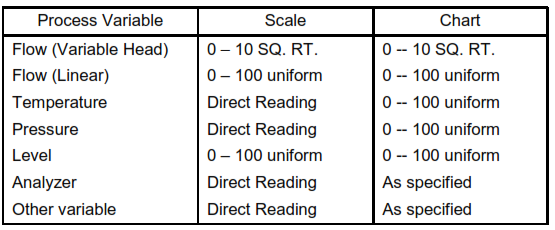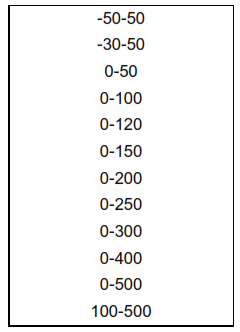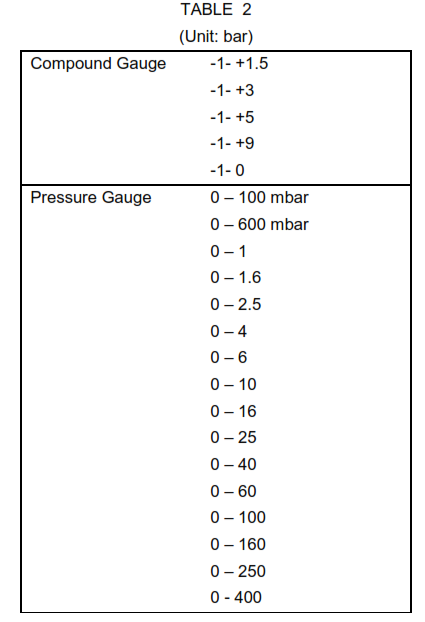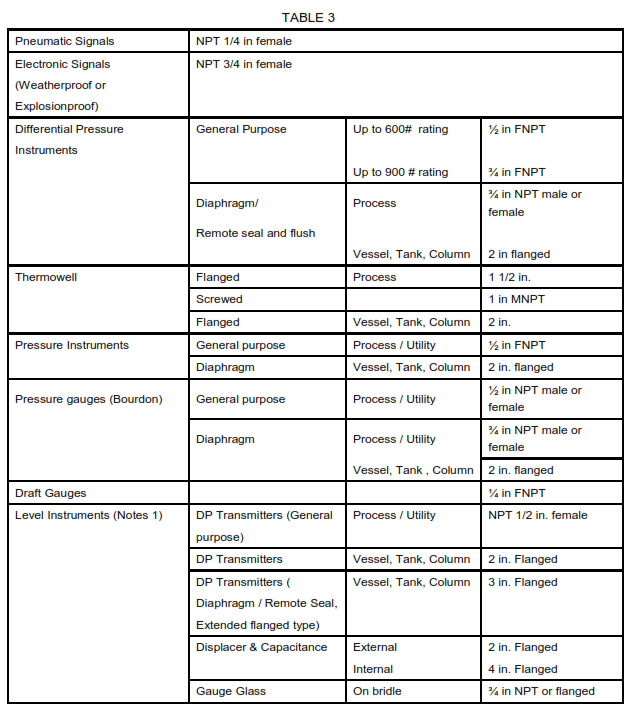General Requirements for Field Instruments in Process Industry
Instruments and control systems shall meet all the applicable requirements of the following industry codes:
- All design and installation of instrument systems shall be in accordance with applicable sections of API RP-551.
- All flanges shall conform to ANSI B16.5.
- All threaded pipe, fittings, valves and connections on instruments shall conform to ASME B1.20.1.
- Bolts, studs and nuts shall conforms to ASTM Standards A 193/A 193M, A 194/A 194M and A 320/A 320M.
- Instrument piping/tubing installations shall meet the requirements of ASME B31.1, ASME B31.3, applicable sections of API RP-551.
- Instrument electrical installations shall meet the requirements of applicable local codes and standards or recommended practices of applicable associations and certifying agencies such as FM, UL, NFPA No. 70, NFPA No. 75, NFPA No. 496, applicable sections of API RP-551, ISA S-12.1 and ISA RP-12.6.
- All instrumentation shall comply with the requirements of the Department of Labor, Occupational Safety and Health Administration (OSHA). \
- Regulations and requirements of the Environmental Protection Agency (EPA) shall be followed in order to meet emission monitoring requirements.
- All instruments shall meet Electrical Area Classification according to their location of installation.
- Units of measurement shall be per local area standards.
- Vessel connections for all directly mounted instruments including bridles shall be minimum 2 in flanged.
- All instruments connected directly to the process shall be purchased with process barriers (seals). If an instrument can not be purchased with two process barriers (seals), Mineral Insulated (MI) type cable shall be used between the instrument and the first fitting.
- All field electronic instruments shall be suitable for withstanding high relative humidity 100 percent, sea wind corrosion, high ambient temperatures (50 deg C), heavy storms, and acid gas corrosion in the air of the plant environment (Max. acid gas -SO2: 500 ppb, H2S: 600 ppb NOX: 5 PPM).
- All instruments shall have at least an RFI protection to radio field in the frequency range from 20 MHz to 1000 MHz and field strength up to 30 volts per meter.
- An instrument shall be sealed, purged, or protected by a diaphragm seal when measuring viscous, highly toxic or corrosive fluids, or fluids with solids. Diaphragm seal unit shall have a flushing connection and wetted parts made of corrosion resistant materials.
- Yoke mounted instruments shall be furnished with a mounting bracket for attachment to an unthreaded end of a 2 inch NPS pipe.
- Signal transmission shall be designed to protect the integrity of the instrument signals from electrical noise caused by electromagnetic interference.
Charts and Indicating Scales
Graduations on charts and scales shall be in accordance with the values shown in Table 1.
Note: A direct reading chart should be used for instruments with large cases.
Standard Ranges Thermometers
Ranges for thermometers shall be selected from the values shown in Table 1.
Pressure Gauges Ranges for pressure gauges shall be selected from the value shown in Table 2.
Connection Sizes Field Instrumentation
Connection sizes for instruments shall confirm to the values shown in Table 3.
Note (1) Connections for external ball float-type level switches shall generally be 1-in. threaded, except for applications on alloy vessels and pressure rating above ANSI Class 600, where connections shall be 1-in. flanged.
Note (2) All connections shall confirm to piping specifications.
Nameplates for Instruments (Excluding – DCS, PLC and Computers)
Nameplates for instruments shall be provided as follows:
a. Local panel-mounted instruments shall have engraved nameplates displaying the tag number and service. Nameplates shall be attached just below the instruments, except that multipoint recorders and indicators may have nameplates on the instruments supplied as manufacturer’s standard accessories.
b. Local panel-mounted instruments shall have an additional nameplate on back of the instrument displaying the tag number only.
c. Field-mounted instruments, such as transmitters, control valves and controllers, shall have nameplates displaying the field tag number and service. Nameplates shall be attached to instruments at a salient position, if practical.
d. Nameplate shall be engraved in English.
Instrument Standards Local Panel Receivers
The following criteria shall be taken into account when selecting and specifying receivers:
a. Miniature instruments shall be used, except for temperature indicators, temperature recorders, general-purpose recorders and other special instruments.
b. Charts for panel-mounted recorders shall be driven by electric motors, and chart drive speeds shall general be approximately 19 to 25 mm per hour except for special case.
c. Indicators integrated with or without manual stations shall be the miniature type and shall be the same dimensions as the proposed controllers.
d. Ribbon type indicators, either electronic or pneumatic, may be used for the pertinent services, such as level indication.
Local Panel Controllers
Balanceless and bumpless automatic-manual transfer switches shall be furnished with every controller, regardless of whether the controller is electronic or pneumatic.
Transmitters
a. Transmitters shall be force balance electronic or pneumatic types.
b. Electronic transmitters shall be smart two-wire types, of high accuracy, with full digital communication (HART or FF (foundation fieldbus)). Use of other fieldbus technologies shall be with approval.
c. Pneumatic transmitters shall be used for local loops and for other applications based on process requirements and OWNER’s approval.
d. Accuracy of transmitter shall not exceed ±0.1 percent of full span.
e. Overall accuracy, including the combined effects of linearity, hysteresis, and repeatability, shall be equal to or better than ±0.1 percent of calibrated span.
f. Drift in transmitter output signal shall not exceed 0.1 percent of the upper range limit of the sensor over a twelve month period.
g. Transmitter output shall not change by more than 0.01 percent of calibrated span for each 1 V (volt) changes from the specified supply voltage requirements.
h. Dead band shall not exceed 0.05 percent, of calibrated span.
i. Transmitter sensing element temperature limits shall be at least -40 to +104oC unless otherwise specified by Contractor.
j. Transmitters shall be explosion proof and conform to hazardous area classification requirements.
k. Transmitters shall have NEMA 4 type enclosure in unclassified areas.
l. Cases for electronic transmitters shall be listed by Factory Mutual (FM) or Underwriters Laboratory (UL) for the National Electrical Code (NFPA 70) area classification Class 1, Groups B, C, and D, Division 2. In addition cases shall be weatherproof NEMA Type 4X in accordance with NEMA ICS 6. Pneumatic transmitters shall not be used, unless directed by Owner.
m. The transmitter enclosure shall have a corrosion protective coating on the outside surface of the box. The P.C. board of the transmitter shall have a corrosion protection film coating.
n. Transmitters shall have screw terminations for the Purchaser’s wiring connections. Terminals shall be marked for polarity, test connections, etc., and shall be in an enclosure suitable for the electrical area classification.
o. All transmitters shall be suitable for universal mounting on either yoke or surface type installation, as specified by Contractor.
p. Body material of transmitter shall generally be 316 stainless steel, unless process conditions require other materials, or manufacturer’s standard product is constructed from superior materials. Transmitters shall include process flanges and adapters.
q. All electronic parts of transmitters shall operate on 24 Vdc power supplies.
r. Flow transmitters shall perform square root operation.
Output Gauges
a. All transmitters shall have remote or integral output gauge.
b. Output gauges shall be provided for executing manual control at field.
c. Local signal indication is required for start-up of equipment or manual operation of equipment.
d. For pneumatic instruments, pressure gauges of 100 mm nominal dial size shall be used for output gauges. Output gauges indicating actual range of the transmitter in process units is preferable.
e. For electronic instruments, output gauges shall be ammeters or voltmeters of manufacturer’s standard with scale of 0-10 square root or 0-100 percent linear, as applicable.
General Requirements for Low Temperature and Cryogenic
Installation In low temperature and plant, the services can be divided into two categories:
- 1 Low temperature service: (approximately -50ºC to 0ºC)
- Cryogenic service: (approximately -50ºC and below).
- Break points between low and cryogenic service may vary for material and/or instrumentinstallation requirements, but are generally defined in the piping material specifications.
- During start-up, shutdown and cool-down periods, a number of instruments in cryogenic service will be subject to higher static pressures than those experienced during normal operation. The Vendor shall ensure that all relevant instruments will withstand these conditions.
- Conventional instruments are normally not suitable for low and cryogenic temperature services. The installation must therefore be arranged such that fluid in contact with these instruments shall be at ambient temperature. However, the pressure retaining parts shall be designed in accordance with the piping or vessel specifications.
- Cold service insulation is expensive, difficult to install and maintain. Instruments and their installations shall be designed to minimize cold service insulation requirements.
- Stainless steel (AISI 316) is to be used.
- All valve-packing materials in low temperature or cryogenic service must be compatible with such conditions, i.e., laminar or filament graphite etc.



